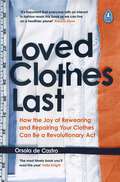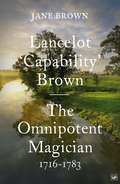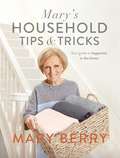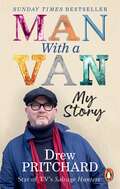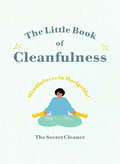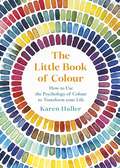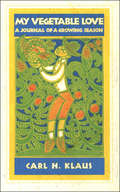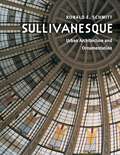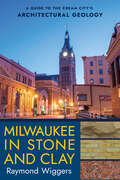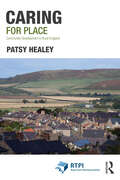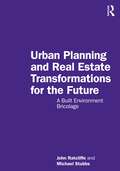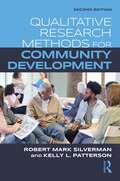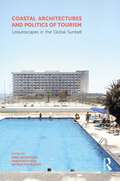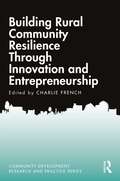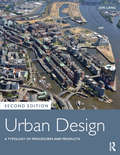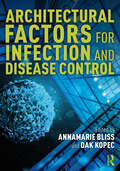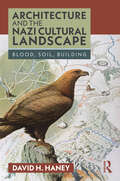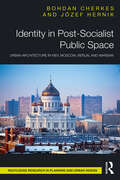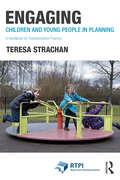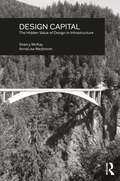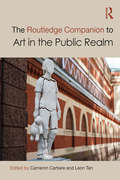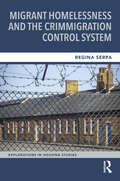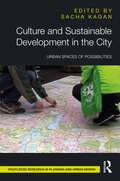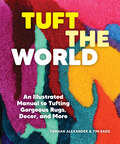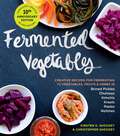- Table View
- List View
Loved Clothes Last: How the Joy of Rewearing and Repairing Your Clothes Can Be a Revolutionary Act
by Orsola de Castro'It's important that everyone with an interest in fashion reads this book so we can live on a healthier planet' Arizona Muse 'The most timely book you'll read this year' India Knight* * * * * Running out of space for the clothes you can't stop buying? Curious about how you can make a difference to the environmental challenges our planet faces? Join Orsola's care revolution and learn to make the clothes you love, last longer.This book will equip you with a myriad of ways to mend, rewear and breathe new life into your wardrobe to achieve a more sustainable lifestyle. By teaching you to scrutinise your shopping habits and make sustainable purchases, she will inspire you to buy better, care more and reduce your carbon footprint by simply making your loved clothes last longer.Following Orsola's practical tips to lavish care and attention on the clothes you already own will not only have a positive environmental impact, but will be personally rewarding too: hand wash, steam and spot clean your clothes, air dry instead of tumble drying, or revive your clothes by sewing or crocheting.Fast fashion leaves behind a trail of human and environmental exploitation. Our wardrobes don't have to be the finish line; they can be a starting point. We can all care, repair and rewear. Do you accept the challenge?* * * * *'An incredibly thoughtful, must-read guide' Kenya Hunt'A must read for anyone who wants to understand the fashion industry as an outsider and wants direction as to where we go next' Aja Barber
Lancelot 'Capability' Brown, 1716-1783: The Omnipotent Magician
by Jane BrownLancelot Brown changed the face of eighteenth-century England, designing country estates and mansions, moving hills and making flowing lakes and serpentine rivers, a magical world of green. This English landscape style spread across Europe and the world. At home, it proved so pleasing that Brown's influence spread into the lowland landscape at large, and into landscape painting. He stands behind our vision, and fantasy, of rural England. In this vivid, lively biography, based on detailed research, Jane Brown paints an unforgettable picture of the man, his work, his happy domestic life, and his crowded world. She follows the life of the jovial yet elusive Mr Brown, from his childhood and apprenticeship in rural Northumberland, through his formative years at Stowe, the most famous garden of the day. His innovative ideas, and his affable and generous nature, led to a meteoric rise to a Royal Appointment in 1764 and his clients and friends ranged from statesmen like the elder Pitt to artists and actors like David Garrick. Riding constantly across England, Brown never ceased working until he collapsed and died in February 1783 after visiting one of his oldest clients. He was a practical man but also a visionary, always willing to try something new. As this beautifully illustrated biography shows, Brown filled England with enchantment - follies, cascades, lakes, bridges, ornaments, monuments, meadows and woods - creating views that still delight us today.
Mary's Household Tips and Tricks: Your Guide to Happiness in the Home
by Mary BerryGet organised in 2022 with Mary Berry's essential household tips that will make home your true happy place'Practical AND beautiful' Graham Norton, BBC Radio 2________'This book is a collection of skills I've learned for running a home. Gleaned from years of practical experience, along with all the hints that friends and family have imparted to me, I hope it will be a helping hand' Mary BerryJoin national treasure Mary Berry in her comprehensive, beautifully illustrated guide that shares her greatest tips on how to care for your home. Inside you'll find . . . - KITCHEN KNOW-HOW: Love the heart of your home with freezer tips and how to organise your food- CLEANING & CONFIGURING YOUR HOME: Create cleaning products from store cupboard items- LAUNDRY & WARDROBE WISDOM: Banish moths from your home for good, remove stains from every kind of fabric- GARDENING & FLOWERS: Bring greenery into your home even without a garden, create beautiful flower arrangementsEasy to use, practical and gorgeously illustrated, Mary's Household Tips & Tricks covers everything from Mary's golden rules for baking to her favourite flowers for each season, from how to polish silver to whether tea should be poured before or after milk.With secrets for accomplishing the most challenging home-keeping tasks with ease, Mary's wonderfully simple book will help turn any house into a home.'The Queen of British baking has whipped up a recipe for home happiness' Independent'A domestic goddess' Daily Telegraph
Man with a Van: My Story
by Drew PritchardSunday Times bestseller'When I see something old, that I think is beautiful, special, valuable, it's not about the money. It's about being in another time and place.'Star of TV's Salvage Hunters, Drew Pritchard will go to the greatest lengths for the best deals. He discovered the casts Lord Elgin made of his infamous marbles in a school garage, and broke the bank to buy the tool box Malcolm Campbell used when he set the water speed record in 1934. He made a million. Lost it. And made it again.The face of the compulsively fascinating business of finding and restoring lost treasures, visionary Drew takes us up and down the country, into garages, factories, schools and pubs, digging out incredible items from that 'other time and place'. Then by lovingly restoring them, he brings our history back to life.A flat cap among silver spoons and old school ties, our favourite no-bullshit expert may be a one-off, but his story makes us all dream of that obscure piece of antiquity gathering dust in the garden shed...
The Little Book of Cleanfulness: Mindfulness in Marigolds!
by The Secret CleanerWhile we are all stuck at home, let's make it a fun place you and your family want to be.Find joy in cleaning your home (yes, really).April, a.k.a. The Secret Cleaner, offers simple and playful ways to clean your space with minimal time and effort AND how to reframe the way you and your family think about cleaning.From Redirecting The Rage Clean to Going Minimal, Making Cleanful Choices to 9 Things Your Forgot to Clean, try April's inventive tips and cheerful challenges to make your home a clean and calming zone.Also including April's Best Cleanful Recipes - quick to make, using natural ingredients, powerful and kind to you and the planet
The Little Book of Colour: How to Use the Psychology of Colour to Transform Your Life
by Karen HallerA SUNDAY TIMES DESIGN BOOK OF THE YEAR_________________________________________The definitive guide for harnessing the power of colour to improve your happiness, wellbeing and confidenceWouldn't you like to boost your confidence simply by slipping on 'that' yellow jumper? Or when you get home after a stressful day, be instantly soothed by the restful green of your walls?The colours all around us hold an emotional energy. Applied Colour Psychology specialist, Karen Haller, explains the inherent power of colour; for example, looking closely at the colours we love or those we dislike can bring up deeply buried memories and with them powerful feelings. A revolutionary guide to boosting your wellbeing, The Little Book of Colour puts you firmly in the driver's seat and on the road to changing the colours in your world to revamp your mood and motivation. Illuminating the science, psychology and emotional significance of colour, with key assessments for finding your own true colour compatibility, this book will help you to rediscover meaning in everything you do through the joy of colour.Get ready to join the colour revolution, and change your life for the better.
My Vegetable Love: A Journal of a Growing Season (Bur Oak Original Ser.)
by Carl H. Klaus&“Home gardeners, cooks and nature lovers will savor this delightful account&” of a journey from first spring planting to final fall harvest (Publishers Weekly). My Vegetable Love is a daily record of a growing season in Iowa—but it&’s about much more than planting peppers, tending tomatoes, or harvesting eggplants. It&’s about all the things that influence this gardener: the weather, the neighborhood, his wife&’s possibly recurring cancer, the changing nature of the academic community. It&’s about the last months of his twenty-year-old cat, about his dog, and about all the other humans and animals in his gardening world. And about his family: the aunts and uncles who cared for and fed a six-year-old orphan, and helped him understand that good food was a way of knowing that someone cared. In all the gardens he has tended, the dills he has pickled, and the dinners he has cooked, Carl H. Klaus has tried to carry on that tradition and pass it on to his own children—and in this &“delectable&” book, he shares it with us as well (Publishers Weekly). &“Part Gilbert White, part Henry David Thoreau, this chronicle of an Iowa gardener&’s year has drawn from the heartland a calm, compassionate harvest.&” —Roger B. Swain, host of PBS&’s Victory Garden &“Wholeheartedly celebrates friendship, love, pets, the elements of family, academia, cooking, eating—and of course, gardening . . . Bon appétit—and good reading.&” —Smithsonian
Sullivanesque: Urban Architecture and Ornamentation
by Ronald E. SchmittSullivanesque offers a visual and historical tour of a unique but often overlooked facet of modern American architecture derived from Louis Sullivan.Highly regarded in architecture for inspiring the Chicago School and the Prairie School, Sullivan was an unwilling instigator of the method of facade composition--later influenced by Frank Lloyd Wright, William Gray Purcell, and George G. Elmslie--that came to be known as Sullivanesque. Decorative enhancements with botanical and animal themes, Sullivan's distinctive ornamentation mitigated the hard geometries of the large buildings he designed, coinciding with his "form follows function" aesthetic.Sullivan's designs offered solutions to problems presented by new types and scales of buildings. Widely popular, they were also widely copied, and the style proliferated due to a number of Chicago-based interests, including the Radford Architectural Company and several decorative plaster and terra-cotta companies. Stock replicas of Sullivan's designs manufactured by the Midland Terra Cotta Company and others gave distinction and focus to utilitarian buildings in Chicago's commercial strips and other confined areas, such as the downtown districts of smaller towns. Mass-produced Sullivanesque terra cotta endured as a result of its combined economic and aesthetic appeal, blending the sophistication of high architectural art with the pragmatic functionality of building design.Masterfully framed by the author's photographs of Sullivanesque buildings in Chicago and throughout the Midwest, Ronald E. Schmitt's in-depth exploration of the Sullivanesque tells the story of its evolution from Sullivan's intellectual and aesthetic foundations to its place as a form of commercial vernacular. The book also includes an inventory of Sullivanesque buildings.Honorable Mention recipient of the 2002 PSP Awards for Excellence in Professional/Scholarly Publishing
Milwaukee in Stone and Clay: A Guide to the Cream City's Architectural Geology
by Raymond WiggersMilwaukee in Stone and Clay follows directly in the footsteps of Raymond Wiggers's previous award-winning book, Chicago in Stone and Clay. It offers a wide-ranging look at the fascinating geology found in the building materials of Milwaukee County's architectural landmarks. And it reveals the intriguing and often surprising links between science, art, and engineering. Laid out in two main sections, the book first introduces the reader to the fundamentals of Milwaukee's geology and its amazing prehuman history, then provides a site-by-site tour guide. Written in an engaging, informal style, this work presents the first in-depth exploration of the interplay among the region's most architecturally significant sites, the materials they're made of, and the sediments and bedrock they're anchored in. Raymond Wiggers crafted Milwaukee in Stone and Clay as an informative and exciting overview of this city. His two decades of experience leading architectural-geology tours have demonstrated the popularity of this approach and the subject matter.
Caring for Place: Community Development in Rural England (ISSN)
by Patsy HealeyThis book draws on preeminent planning theorist Patsy Healey’s personal experiences as a resident of a small rural town in England, to explore what place and community mean in a particular context, and how different initiatives struggle to get a stake in the wider governance relations while maintaining their own focus and ways of working. Throughout the book, Healey assesses the public value generated by community initiatives and the impact of such activity on wider governance dynamics.Healey explores the power which small communities are able to mobilise through self-organisation and grassroots activism. Through the lens of Wooler and Glendale as a micro-society, the book centres on a community experiencing an economic and demographic transition. It focuses on three initiatives developed and led by local people – a small community development trust, an informal attentionmobilising network, and a Neighbourhood Plan project which uses an opportunity provided within the formal planning system. It examines how, in such civil society activism, people came together to promote local development in a place and community neglected by the dominant political economy.The book details the power and force of community initiative and its potential for transforming both the future possibilities for the place and community itself, as well as wider governance relations. Overall, it seeks to enrich academic and policy discussion about how the relations between formal government and civil society energy could evolve in more productive and progressive directions.
Urban Planning and Real Estate Transformations for the Future: A Built Environment Bricolage
by John Ratcliffe Michael StubbsThis book presents fresh ways of thinking about the future for all those involved in conceiving, planning, designing, funding, constructing, occupying and managing the built environment, to face the challenges, and grasp the opportunities, that lie ahead over the next few decades. Four major themes form the basis of the volume:(1) Future Awareness and a New Sense of Place.(2) Global Governance and Anticipatory Leadership. (3) Innovation, Reform and Exemplars. (4) Urban Planning and Real Estate Transformations. Within these structural themes are a diverse range of 'Discourses' addressing many of the big questions and driving forces that face us, together with a proposed methodology (Strategic Foresight) and an array of practical illustrations viewing what can be done today – whether by organisations, individuals, cities or communities – to positively shape a preferred future and manipulate us towards achieving it. It will be important reading for students, practitioners, agencies and corporations across the built environment, especially in the fields of urban planning, real estate development, architecture, civil engineering and construction.
Qualitative Research Methods for Community Development
by Robert Mark Silverman Kelly PattersonThe second edition of Qualitative Research Methods for Community Development teaches the basic skills, tools, and methods of qualitative research with special attention to the needs of community practitioners. This book teaches students entering planning, community development, nonprofit management, social work, and similar applied fields the core skills necessary to conduct systematic research designed to empower communities and promote social change.Focusing on the basic elements of qualitative research, such as field observation, interviewing, focus groups, and content analysis, this second edition of this book provides an overview of core methods and theoretical underpinnings of successful research. It also includes two new chapters on qualitative data analysis software and techniques for conducting online qualitative interviews and focus groups.From housing, community organizing, neighborhood planning, and urban revitalization, this book gives students the skills they need to undertake their own projects and provides professionals a valuable reference for their future research. This book serves as a primary text for courses in applied qualitative research and as a reference book for professionals and community-based researchers.
Coastal Architectures and Politics of Tourism: Leisurescapes in the Global Sunbelt
by Sibel BozdoǧanThis volume offers a critical and complicated picture of how leisure tourism connected the world after the World War II, transforming coastal lands, traditional societies, and national economies in new ways.The 21 chapters in this book analyze selected case studies of architectures and landscapes around the world, contextualizing them within economic geographies of national development, the geopolitics of the Cold War, the legacies of colonialism, and the international dynamics of decolonization. Postwar leisure tourism evokes a rich array of architectural spaces and altered coastal landscapes, which is explored in this collection through discussions of tourism developments in the Mediterranean littoral, such as Greece, Turkey, and southern France, as well as compelling analyses of Soviet bloc seaside resorts along the Black Sea and Baltic coasts, and in beachscapes and tourism architectures of western and eastern hemispheres, from Southern California to Sri Lanka, South Korea, and Egypt. This collection makes a compelling argument that "leisurescapes," far from being supra-ideological and apolitical spatial expressions of modernization, development, and progress, have often concealed histories of conflict, violence, social inequalities, and environmental degradation. It will be of interest to architectural and urban historians, architects and planners, as well as urban geographers, economic and environmental historians.
Building Rural Community Resilience Through Innovation and Entrepreneurship (ISSN)
by Charlie FrenchDrawing from empirical analyses, case studies, and a synthesis of best practices, this book explores how innovation manifests itself in rural places and how it contributes to entrepreneurial development and resilience. Innovation in rural places may come about as a result of new forms of collaboration; policies that leverage rural assets and address critical service or product gaps; novel strategies for accessing financial capital; infusion of arts into aspects of community life; and cultivation of networks that bridge entrepreneurs, organizations, and institutions. The chapters illustrate how a number of innovation-related characteristics relate to economic vibrancy in rural places such as a strong connection to the arts, adaptive and sustainable use of natural resources, value-chain integrated food systems, robust bridging social capital networks, creative leveraging of technology, and presence of innovation-focused entrepreneurs. Through exploration of these and other topics, this book will provide insights and best practices for rural community and economic development scholars and practitioners seeking to strengthen the rural innovation ecosystem.
Urban Design: A Typology of Procedures and Products
by Jon LangUrban Design: A Typology of Procedures and Products, 2nd Edition provides a comprehensive and accessible introduction to urban design, defining the field and addressing the controversies and goals of urban design. Including over 50 updated international case studies, this new edition presents a three-dimensional model with which to categorize the processes and products involved: product type, paradigm type, and procedural type. The case studies not only illuminate the typology but provide information that designers can use as precedents in their own work. Uniquely, these case study projects are framed by the design paradigm employed, categorized by procedural type instead of instrumental or land use function. The categories used here are Total Urban Design, All-of-a-piece Urban Design, Plug-in Urban Design, and Piece-by-piece Urban Design.Written for both professionals and those encountering urban design in their day-to-day life, Urban Design is an essential introduction to the field and practice, considering the future direction of the field and what can be learned from the past.
Architectural Factors for Infection and Disease Control
by AnnaMarie Bliss Dak KopecThis edited collection explores disease transmission and the ways that the designed environment has promoted or limited its spread. It discusses the many design factors that can be used for infection and disease control through lenses of history, public health, building technology, design, and education.This book calls on designers to consider the role of the built environment as the primary source of bacterial, viral, and fungal transfers through fomites, ventilation systems, and overcrowding and spatial organization. Through 19 original contributions, it provides an array of perspectives to understand how the designed environment may offer a reprieve from disease. The authors build a historical foundation of infection and disease, using examples ranging from lazarettos to leprosy centers to show how the ability to control infection and disease has long been a concern for humanity. The book goes on to discuss disease propagation, putting forth a variety of ideas to control the transmission of pathogens, including environmental design strategies, pedestrian dynamics, and open space. Its final chapters serve as a prospective way forward, focusing on COVID-19 and the built environment in a post-pandemic world.Written for students and academics of architecture, design, and urban planning, this book ignites creative action on the ways to design our built environment differently and more holistically.Please note that research on COVID-19 has exponentially grown since this volume was written in October 2020. References cited reflect the evolving nature of research studies at that time.
Architecture and the Nazi Cultural Landscape: Blood, Soil, Building
by David H. HaneyThis book traces cultural landscape as the manifestation of the state and national community under the Nazi regime, and how the Nazi era produced what could be referred to as a totalitarian cultural landscape.For the Nazi regime, cultural landscape was indeed a heritage resource, but it was much more than that: cultural landscape was the nation. The project of Nazi racial purification and cultural renewal demanded the physical reshaping and reconceptualization of the existing environment to create the so-called "new Nazi cultural landscape." One of the most important components of this was a set of monumental sites thought to embody blood and soil beliefs through the harmonious synthesis of architecture and landscape. This special group of "landscape-bound" architectural complexes was interconnected by the new autobahn highway system, itself thought to be a monumental work embedded in nature. Behind this intentionally aestheticized view of the nation as cultural landscape lay the all-pervasive system of deception and violence that characterized the emerging totalitarian state.This is the first historical study to consider the importance of these monumental sites together with the autobahn as evidence of key Nazi cultural and geographic strategies during the pre-war years. This book concludes by examining racial and nationalistic themes underlying cultural landscape concepts today, against this historic background.
Identity in Post-Socialist Public Space: Urban Architecture in Kiev, Moscow, Berlin, and Warsaw (Routledge Research in Planning and Urban Design)
by Bohdan Cherkes Józef HernikThis book is a comparative analysis of the architecture of central public spaces of capital cities in Central and Eastern Europe during the period of their authoritarian and post-authoritarian development. It demonstrates that national identity transformations cause structural changes in urban public spaces, and theorises identity and national identity within urban planning in order to explain the influence of historical, cultural, mental, social as well as ideological and political conditions on the processes of shaping and perceiving the architecture of public space. The book addresses the process of shaping and restructuring historic centres of European capital cities of Kiev, Moscow, Berlin, and Warsaw, which developed under authoritarian regime conditions throughout the 20th century and were characterised by ideological determinism and the influence of state ideology and politics on the architecture of public spaces. The book will be useful for urban planners, architects, land management specialists, art historians, political scientists, and readers interested in the theory and history of cities, the fundamentals of urban planning and architecture, and the planning of cities and public spaces.
Engaging Children and Young People in Planning: A Handbook for Transformative Practice (ISSN)
by Teresa StrachanEngaging Children and Young People in Planning places planners’ skills for engagement with children and young people centre stage by discussing several projects delivered or supported by planning students to young people in the Northeast of England. Urban or town and country planning is a largely unfamiliar concept to children and young people. Moreover, in England, the environment in which young people live, play and go to school is shaped by a local planning process which lacks their input. This book explores the nature of the gap between that planning process and the voice of the younger members of the community, as well as the barriers that impede this engagement. It highlights why an engagement process is beneficial for those young people, for the wider community and for the planning process itself. At a time when our relationship with and impact on, the environment is being re-examined, this book challenges the planning professional to identify, develop and reflect upon the engagement skills that will help to transform planning into a more inclusive practice. It will be of use to scholars and practitioners in urban planning, community planning, engagement and children’s rights, whilst supporting their academic and professional development pathways.
Design Capital: The Hidden Value of Design in Infrastructure
by Sherry McKay AnnaLisa MeyboomWell-designed infrastructure brings social value that far exceeds its initial construction expenditure, but competition for scarce government funds and a general public perception of infrastructure as mere efficiency, has often left design ill-considered. This book provides designers with the tools needed to argue for the value of design: the ‘design capital’ as the authors term it. In naming and defining design capital, design can once again become part of the discussion and realization of every infrastructure project.Design Capital offers strategies and tools for justifying public spending on design considerations in infrastructure projects. Design has the ability to make infrastructure resonate with cultural or social value, as seen in the case studies, which bestows infrastructure with the potential to accrue design capital. Support for this proposition is drawn from various methodologies of economic valuation and Bourdieu’s theory of cultural capital, explanation of design methodology and education and a series of historical and contemporary case studies. The book also addresses some of the more controversial outcomes associated with contemporary infrastructure: gentrification, globalization and consumer tourism.With this book, designers can make a stronger case for the value of design in public infrastructure.
The Routledge Companion to Art in the Public Realm (Routledge Art History and Visual Studies Companions)
by Cameron CartiereThis multidisciplinary companion offers a comprehensive overview of the global arena of public art.It is organised around four distinct topics: activation, social justice, memory and identity, and ecology, with a final chapter mapping significant works of public and social practice art around the world between 2008 and 2018. The thematic approach brings into view similarities and differences in the recent globalisation of public art practices, while the multidisciplinary emphasis allows for a consideration of the complex outcomes and consequences of such practices, as they engage different disciplines and communities and affect a diversity of audiences beyond the existing 'art world'. The book will highlight an international selection of artist projects that illustrate the themes.This book will be of interest to scholars in contemporary art, art history, urban studies, and museum studies.
Migrant Homelessness and the Crimmigration Control System (ISSN)
by Regina SerpaMigrant Homelessness and the Crimmigration Control System offers new insights into the drivers of homelessness following migration by unpacking the housing consequences of ‘crimmigration’ control systems in the US and the UK. The book advances ‘housing sacrifice’ as a concept to understand journeys in and out of homelessness and the coping strategies migrants employ. Undergirded by persuasive empirical research, it offers a compelling case for a ‘social citizenship’ right to housing guaranteed across social, political and civil realms of society. The book is structured around the 30 life stories of people who have migrated to the capital cities of Boston and Edinburgh from Central America and Eastern Europe. The narratives are complemented by interviews with a range of stakeholders (including frontline caseworkers, activists and policymakers). Guided by the tenets of critical realist theory, this book offers a biographical inquiry into the intersections of race, class and gender and provides insight into the everyday precarity homeless migrants face, by listening to them directly. It will be of interest to students, scholars, and policymakers across a range of fields including housing, immigration, criminology, sociology, and human geography.
Culture and Sustainable Development in the City: Urban Spaces of Possibilities (Routledge Research in Planning and Urban Design)
by Sacha KaganThis book exposes the potential to advance a cultural approach to sustainable urban development. It explores urban "spaces of possibilities" and links them to the seized or missed opportunities for innovative forms of transversal partnerships throughout the city and of culturally sensitive urban policies.The call for sustainability brings with it challenges for which, in view of the urgency of social transformation, institutional innovations are necessary. Sustainable urban development will only succeed through creative impulses, experiments, trying out innovative ideas, and making alternatives visible, in particular through locally rooted urban initiatives, artistic actions, and social movements. Discussing many concrete examples from several years of empirical research in the cities of Hanover and Hamburg (Germany), Baltimore and Chicago (USA), Bangalore (India), St. Petersburg (Russia), Singapore, and Vancouver (Canada), the book connects urban spaces and their actors; looks at their guiding principles, strategies, and concrete practices; and identifies new levers, networks, and alliances. Readers will find in this book not only inspiring examples of culture in everyday life in the city but also explanations about the qualities that make local cultural initiatives especially full of potentials, and how they may translate into city-wide changes, engaging with the whole City as Space of Possibilities.The book will interest researchers and advanced students in the interdisciplinary fields of urban studies, sustainability science/sustainability research, cultural sciences, urban sociology, and sociology of the arts/cultural sociology; and those interested in the transdisciplinary collaborations between the arts, academia, and civil society.
Tuft the World: An Illustrated Manual to Tufting Gorgeous Rugs, Decor, and More
by Tiernan Alexander Tim EadsA visual how-to guide on the craft of tufting rugs, home decor, and more from the duo behind Tuft the World, the tufting company that has helped launch and educate a new generation of tufters.Tuft the World is an easy-to-follow and beautifully illustrated guide to tufting, whether you’re creating your first project or are a seasoned tufter. Brought to you by the preeminent experts in the machine-tufting field, this detailed crafting guide shows you, through step-by-step instructions and 175 full-color photographs, how to create contemporary, stylish, and enjoyable machine-tufted rugs, clothes, and objects. Within these pages, you'll learn about:Tufting machines, materials, and techniquesWorkspace setupHow to create projects from start to finish, including everything from a bathmat, bedside rug, shawl collar, or chair slipcover to a picture frame, sculptural work of art, or stunning tufted cat tree!Contemporary rug artists and their designsThe history of tufting and some of the women and men whose inventions brought the craft to lifeAnd moreUnlike online videos about tufting, this book is a long-lasting reference showcasing the versatility and creativity of the craft by the experts—a highly accessible, thorough, and enriching guide. Included throughout are sidebars on the historical context for amateur and professional rug-making in America and spotlights on current tufting makers.This much-needed companion introduces and expands knowledge for the many new and experienced tufters interested in the booming craft of machine-tufted rugs and decor. Inspiring and simple to follow, this book is sure to make a tufter out of anyone.
Fermented Vegetables, 10th Anniversary Edition: Creative Recipes for Fermenting 72 Vegetables, Fruits, & Herbs in Brined Pickles, Chutneys, Kimchis, Krauts, Pastes & Relishes
by Kirsten K. Shockey Christopher ShockeyThis updated and revised bestselling guide to fermenting vegetables shares 65 new recipes, 8 new vegetable and fruit entries, 12 new producer profiles, 4 new fermentation techniques, and a greater emphasis on zero-waste processes. Since the first edition of Fermented Vegetables was published in 2014, enthusiasm for fermentation has bubbled over—in part, because of the ongoing research into the importance of gut health. Unlike other forms of food preservation, fermenting offers the benefit of boosting gut health while introducing unique flavors into ordinary dishes. Kirsten and Christopher Shockey have been at the forefront of the fermentation movement and are two of its most widely respected teachers. Fermented Vegetables has become the go-to reference for people who want to start fermenting; its broad scope, accessible recipes, and attractive package, combined with the Shockeys&’ authority, are a winning combination. The second edition of the book builds on the success of the first, with new techniques like using Japanese pickle beds and turning ferments into seasoning pastes and powders. It includes 65 new recipes; other recipes that utilize fermented foods have been revised to minimize the use of animal products and alcohol. In addition, the authors have written 8 new fruit and vegetable entries and 12 new profiles, which feature producers from around the world. All information about the science of gut health has been updated to reflect the enormous amount of research that has been done over the last decade.
